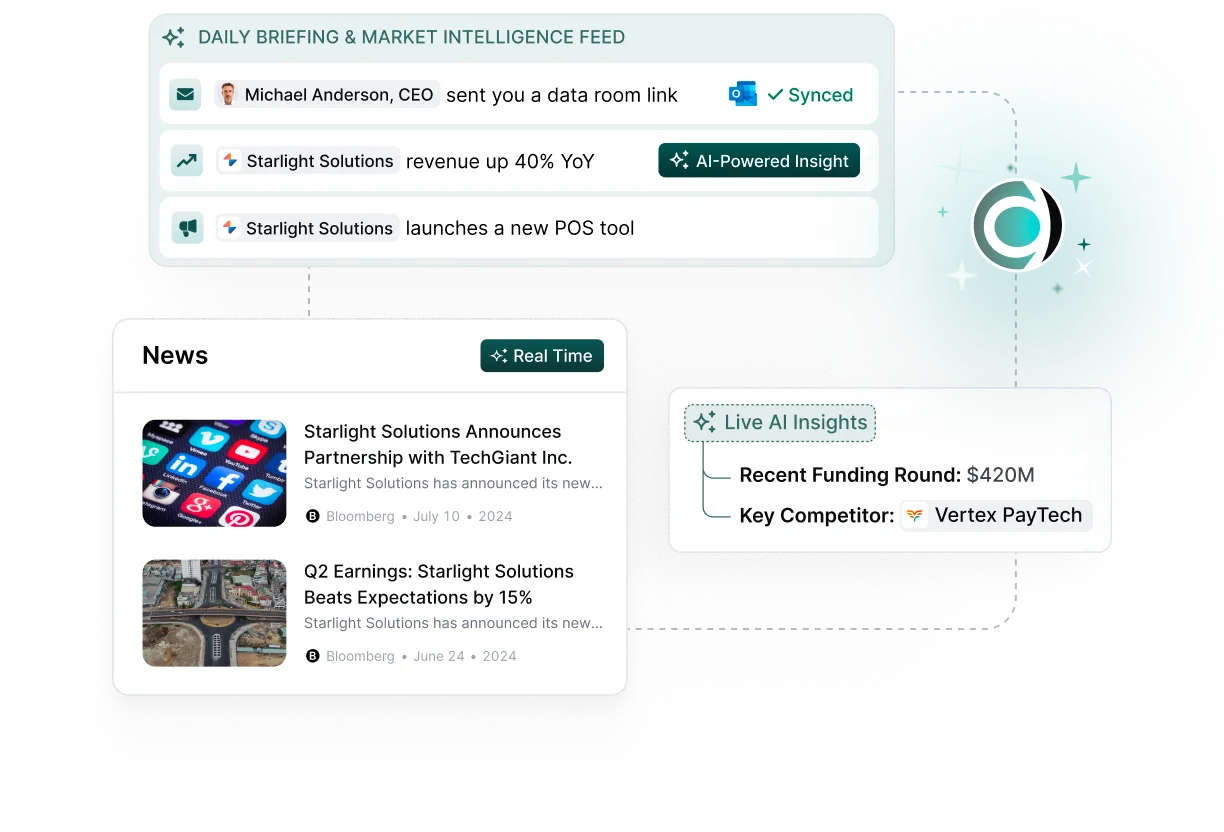Meridian raises $7M seed round led by 645 Ventures.
Read More
Discover why the most valuable private equity due diligence insights come from conversations, not spreadsheets, and how to build systematic conversation intelligence.

Every private equity associate knows the ritual: arrive at the data room, open the first of dozens of Excel models, and begin the methodical process of verifying assumptions, stress-testing scenarios, and building the investment case. It's necessary work, foundational even. But after years in private equity and countless hours in data rooms, I've learned that the spreadsheets rarely tell you what actually determines success or failure.
The real intelligence—the insights that save deals or expose hidden value—comes from conversations. Not the formal management presentations or scripted Q&A sessions, but the unguarded moments when a customer explains why they're really leaving, or when a floor supervisor mentions the workaround everyone uses because the "standard" system hasn't worked in years.
Modern due diligence has become increasingly sophisticated. We have AI-powered analysis tools, complex Monte Carlo simulations, and datasets that would have been unimaginable a decade ago. Yet according to Bain & Company, 60% of deals still fail to meet their value creation targets. Why?
The answer lies in what spreadsheets can and cannot capture. Financial models excel at quantifying the known—historical performance, market sizes, cost structures. They're terrible at surfacing the unknown—cultural dysfunction, competitive threats brewing beneath the surface, or customer relationships hanging by a thread.
Consider this: A model might show 5% annual customer churn, neatly projected forward for five years. But it can't tell you that three of your top ten customers have been interviewing replacement vendors for the past six months. That intelligence only comes from conversations.
Through dozens of deals, certain types of conversations consistently revealed game-changing insights that never appeared in any data room:
The Customer Truth Sessions
The CIM showed 95% customer satisfaction scores. The model projected stable retention. But when we spoke with customers directly—especially former customers—a different story emerged. One conversation with a recently churned enterprise client revealed that the company's product roadmap had diverged from market needs eighteen months ago. The satisfaction scores were high because unhappy customers were leaving before the survey cycle.
This pattern repeats across industries. McKinsey research shows that direct customer conversations during diligence identify 3x more risks than survey data analysis alone. The difference? Surveys capture what customers are willing to write down. Conversations capture what they're actually thinking.
The Competitor Intelligence Networks
Every model includes competitive analysis, usually a neat 2x2 matrix positioning the target favorably. But talking to former executives from competing companies reveals the battles being fought below the surface.
In one technology deal, a competitor's former head of product mentioned they had abandoned a similar market approach two years earlier—not because it didn't work, but because a major platform change was coming that would obsolete the entire category. This wasn't in any analyst report. The target company had no idea. That single conversation saved us from a catastrophic investment.
The Front-Line Reality Check
Management presentations showcase best practices and standard operating procedures. The models assume these processes work as designed. But front-line employees tell you what actually happens when systems meet reality.
A manufacturing deal looked perfect on paper—lean processes, Six Sigma certifications, impressive efficiency metrics. Conversations with floor supervisors revealed a different reality: the ERP system hadn't been properly updated in three years, and everyone was running shadow Excel spreadsheets to keep production moving. What looked like operational excellence was actually heroic improvisation masking systematic failure.
The power of conversations in diligence isn't accidental—it's rooted in how humans communicate and how organizations actually function:
Information Asymmetry: People share different information in different contexts. What someone will document in writing differs vastly from what they'll share in a trusted conversation. The most critical information is often the least documented.
Emotional Intelligence: Numbers don't capture frustration, fear, or excitement. But these emotions drive behavior. A conversation with a sales leader who's excited about the product roadmap tells you something no pipeline model can capture. Conversely, detecting resignation in a CTO's voice might signal technical debt that hasn't yet manifested in the metrics.
Network Effects: Organizations are networks of relationships, not hierarchies on paper. Conversations reveal the real power dynamics, communication patterns, and cultural currents that determine execution capability. You learn who actually makes decisions, which departments don't talk to each other, and where organizational scar tissue from past failures still affects behavior.
Temporal Dynamics: Models show snapshots and trends, but conversations reveal timing and momentum. Is the sales team's morale improving or declining? Is the technical debt being addressed or accumulating? These trajectory questions require human insight.
Our vertically integrated AI provides an intelligence engine that powers your entire deal workflow.

The challenge is that most firms treat conversations as an ad-hoc supplement to "real" diligence rather than a systematic discipline. Here's how to change that:
1. Map the Conversation Ecosystem
Before starting diligence, map all stakeholder groups that could provide valuable intelligence:
2. Design Conversation Protocols
Structure conversations for intelligence gathering, not just validation:
3. Triangulate Intelligence
Single conversations provide anecdotes; multiple conversations reveal patterns:
4. Integration with Quantitative Analysis
The goal isn't to replace spreadsheet analysis but to enhance it:
Historically, conversation intelligence has been limited by human bandwidth. You can only have so many conversations, and capturing insights has been manual and inconsistent. But new technologies are changing this dynamic:
AI-Powered Conversation Analysis: Natural language processing can now analyze conversation transcripts to identify patterns, sentiment changes, and risk signals across hundreds of conversations simultaneously.
Network Mapping Tools: Modern CRM and intelligence platforms can map relationship networks to identify the most valuable conversations to prioritize.
Digital Reference Checking: Automated platforms can gather structured feedback from broader stakeholder groups than traditional methods allowed.
Sentiment Tracking: Tools that monitor employee review sites, customer forums, and social media provide continuous conversation intelligence beyond the diligence period.
In an era of increasing quantification and automation, the firms that excel at gathering and synthesizing human intelligence will have a sustained competitive advantage. Here's why:
Differentiated Insights: Everyone has access to the same financial data and increasingly similar analytical tools. Conversation intelligence provides unique, proprietary insights.
Early Warning Systems: Conversations surface weak signals before they appear in metrics. Cultural problems, competitive threats, and customer dissatisfaction all show up in conversations months or years before they impact financial performance.
Value Creation Roadmaps: Post-acquisition success depends on understanding the human dynamics of the organization. Conversation intelligence gathered during diligence becomes the foundation for successful integration and value creation.
Relationship Capital: The process of having these conversations builds relationships that become valuable beyond the immediate deal—with industry experts, customer networks, and potential future targets.
For firms looking to enhance their conversation intelligence capabilities, here's a practical roadmap:
Phase 1: Pilot Program (Weeks 1-4)
Phase 2: Process Development (Months 2-3)
Phase 3: Technology Integration (Months 4-6)
Phase 4: Continuous Improvement (Ongoing)
The future of private equity due diligence isn't about choosing between spreadsheets and conversations—it's about integrating both into a comprehensive intelligence system. The firms that win will be those that maintain quantitative rigor while building equally sophisticated capabilities in human intelligence gathering.
As AI and automation handle more of the routine analytical work, the ability to have meaningful conversations, build trust quickly, and extract non-obvious insights from human interactions becomes even more valuable. These are skills that can't be automated and insights that can't be modeled.
The next time you're in a data room, surrounded by monitors displaying endless Excel models, remember: the numbers will likely confirm what you expect. But somewhere out there—in a customer's office, on a factory floor, or in a competitor's alumni network—someone has information that could change everything about how you see this deal.
The question isn't whether that intelligence exists. It's whether you'll find it before you sign.
Discover how Meridian can streamline deal sourcing and enhance your decision-making

Meridian enables data-driven deal evaluation for smarter investment committee outcomes.

Table of Contents


Learn how to build a repeatable sector research program that helps your firm surface targets earlier, improves outreach, and speeds IC decisions.

